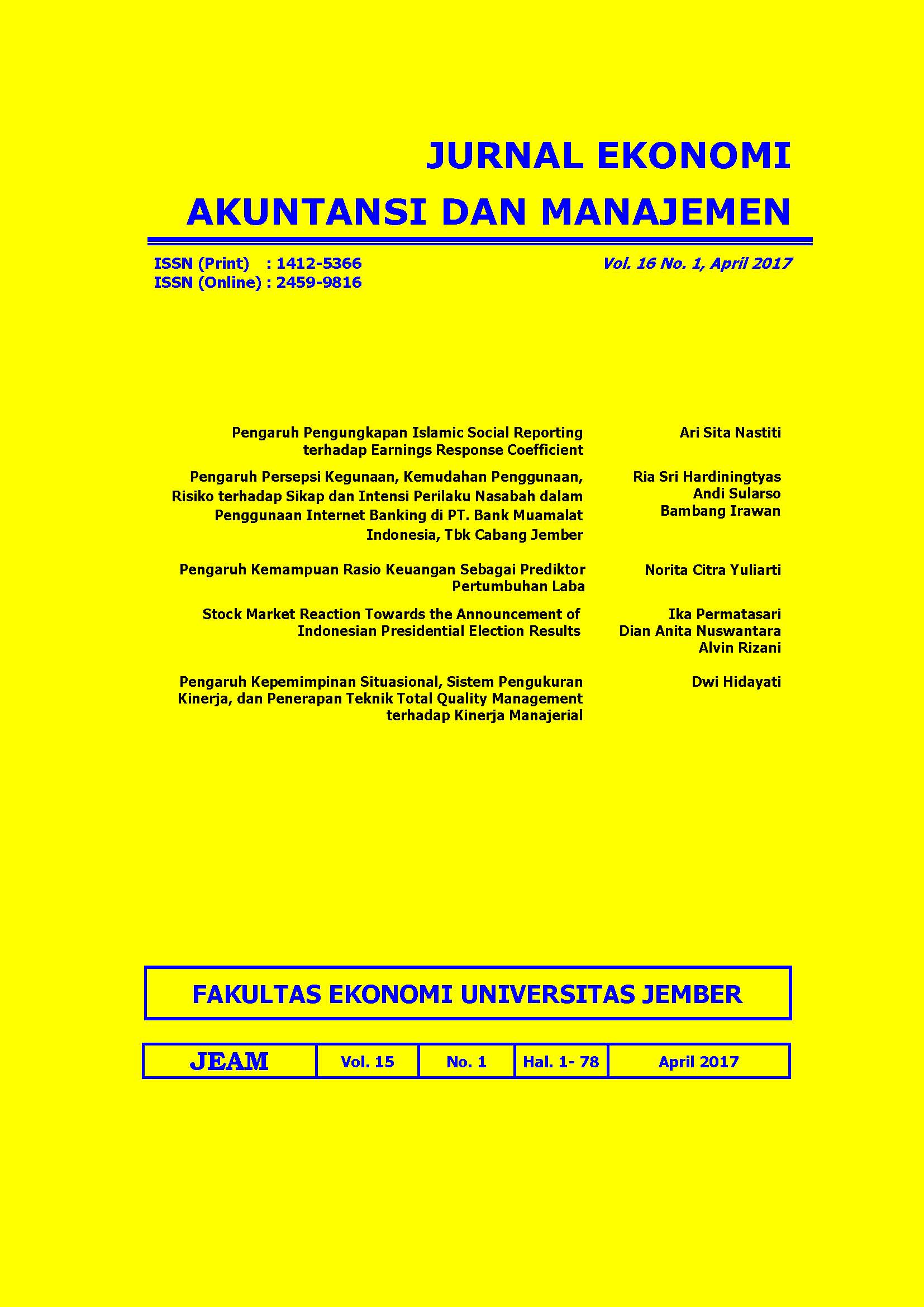Pengaruh Persepsi Kegunaan, Kemudahan Penggunaan, Risiko terhadap Sikap dan Intensi Perilaku Nasabah dalam Penggunaan Internet Banking di PT. Bank Muamalat Indonesia, Tbk Cabang Jember
Abstract
This study aims to examine the factors that influence customer behavior intention on internet banking services by adopting a conceptual framework Technology Acceptance Model (TAM) developed by Davis in 1989 in PT Bank Muamalat Indonesia, Tbk. Jember Branch. The data collection is done by distributing 200 questionnaires to customers who use internet banking services. Results of the test data showed that the perceived of usefulness, ease of use, and risk significantly affect the attitude of the use of internet banking but the behavioral intention variable significantly influenced only by the perceived ease of use variable. Attitude variable significantly influence behavior intention variable. These results indicate that the behavior intention to use internet banking service foremost influenced by the easiness of the application. A usefull service will not necessarily be used when deemed difficult to operate. The risk factor was not affect the intention of customers to continue using internet banking services. Internet banking services of PT Bank Muamalat Indonesia, Tbk. Jember branch should be more focused on the easiness of the application and the dissemination about how to use this service which in turn can reduce the operational costs of banks in providing banking services.
Keywords: Technology Acceptance Model (TAM), internet banking, perceived usefulness, perceived ease of use, perceived risk, attitudes, behavior intention, Structural Equation Model
References
Bashir, Irfan dan Madhavaiah, C. 2014. Determinants of Young Customers’s Intention to Use Internet Banking Service in India. Vision, Vol. 18(3):153-163
Chau, Patrick Y. K., dan Vincent S. K. Lai. 2003. An Empirical Investigation of The Determinants of User Acceptance of Internet Banking, Journal of Organizational Computing and Electronic Commerce 13(2), pp. 123-145.
Chinakidzwa, More. 2014. Impact of Marketing Communications on Customer Attitudes towards. Internet Banking Adoption by University Students in Zimbabwe-Case of Harare Institute of Technology. Journal of Business Administration and Education, Vol. 6(1):1-14
Daneshgadeh, Salva, dan Yildirim, O. Sevgi. 2014. Empirical Investigation of Internet Banking Usage: The Case of Turkey. Procedia Technology, Vol.16:322-331
Davis, F.D. 1989. Perceived Usefulness, Perceived Easy of Use, and User Acceptance of Informatiom Technology”, MIS Quarterly, Vol. 13, No. 5, pp. 319-339.
Davis, F.D. 1993. User Acceptance of Information Technology: System Characteristics, User Perceptions and Behavioral, International Journal Management Machine Studies, Vol. 38, pp. 475-487.
Ferdinand, Augusty. 2002. Sctructural Equation Modeling dalam Penelitian Manajemen. Semarang: Badan Penerbit Universitas Diponegoro.
George, Ajimon, dan Kumar, Giresh, G.S. 2013. Antecedents of Customer Satisfication in Internet Banking: Technology Acceptance Model (TAM) Redefined. Global Business Review, Vol.14, No. 4, pp. 627-638.
Ghozali, Imam. 2008. Model Persamaan Struktural : Konsep dan Aplikasi dengan Program AMOS 16.0. Semarang : badan penerbit Universitas Diponegoro.
Ghozali, Imam. 2014. Model Persamaan Struktural: Konsep dan Aplikasi dengan Program Amos 22.0 Update Baynesian SEM. Semarang: Badan Penerbit Universitas Diponegoro.
Hojjati, et al. 2015. Evaluation of Factors Influencing Internet Banking Acceptance by Internet Users in Iran. International Journal of Advanced Networking and Application, Vol. 6(6):2503-2519.
Hoppe, Rudi., Paul Newman., dan Pauline Mugera. 2001. Factors Affecting the Adoption of Internet banking in South Africa: a Comparatice Study, ER Project, in Partial Fullfillment of the Requirements for The Course on Information Systems Honours (INF 414 W).
Jahangir, Nadim., dan Noorjahan Begum. 2008. The Role of Persepsi kegunaan, Persepsi kemudahaan penggunaan, Security and Privacy, and Customer Attitude toEngender Customer Adaption in The Context of Electronic Banking, African Journal of Business Management, February, Vol. 2, No. 1, pp. 032-040.
Kassim, Md. Normalini, dan Ramayah, T. 2015. Perceived Risk Factors Influence on Intention to Continue Using Internet Banking among Malaysians. Global Business Review, Vol.16(3):393-414.
Kusuma, Hadri., dan Dwi Susilowati. 2007. Determinan Pengadopsian Layanan Internet Banking: Perspektif Konsumen Perbankan Daerah Istimewa Yogyakarta, Jurnal Akuntasi dan Auditing Indonesia, Desember, Vol. 11, No. 2, pp. 125-139.
Kurniawati, H.A., Arif, A. dan Winarno, W.A., 2017. Analisis minat penggunaan mobile banking dengan pendekatan Technology Acceptance Model (TAM) yang telah dimodifikasi. e-Journal Ekonomi Bisnis dan Akuntansi, 4(1), pp.24-29.
Maharsi, Sri dan Fenny. 2006. Analisa Faktor-faktor yang Mempengaruhi Kepercayaan dan Pengaruh Kepercayaan Terhadap Loyalitas Internet Banking di Surabaya. Jurnal Akuntansi dan Keuangan, Vol. 8, No.1, pp. 35-39.
Manzano, Joaquin Aldas., Carlos lassala-Navarre., Carla Ruiz-Mafe, dan Salva. 2009. Key Drivers of Internet Banking Services Use, Online Information Review, Vol. 22, No. 4, pp. 672-695.
Medyawati, Henny., Marieta Christyanti., dan Muhammad Yunanto. 2011. E-Banking Adoption Analysis Using Technology Acceptance Model (TAM): Empirical Study of Bank Customers in Bekasi City, International Conference on Innovation, Management, and Service,Vol. 14, pp. 91-95.
Nasri, Wadie. 2011. Factors Influencing the Adoption of Internet Banking in Tunisia. International Journal Business and Management, Vol. 6(8):143-159.
Ozdemir, et al. 2008. Segmenting Internet Banking Adopter and Non-Adopters in The Turkish Retail Banking Sector. International Journal of Bank Marketing, Vol.26 (4):212-215.
Purwanegara, dkk. 2014. Snapshot on Indonesia Regulation in Mobile Internet Banking Users Attitude. Social and Behavioral Sciences, Vol.115:147-155.
Rigopoulos, George., Dimitrios Askounis. 2007. A TAM Framework to Evaluate User’s Perception Toward Online Electronic Payments. Journal of Internet Banking and Commerce, Desember, Vol. 12, No. 3, pp. 1-5.
Sabi, M. Humphrey. 2014. Research Trends in The Disffusion of Internet Banking in Developing Countries. Journal of Internet Banking and Commerce, Vol. 19 (2):1-32.
Santouridis, Ilias, dan Kyritsi, Maria. 2014. Investigating The Determinants of Internet Banking Adoption in Greece. Procedia Economics and Finance, Vol.9:501-510.
Sathye, Milind. 1999. Adoption of Internet banking by Australian Consumers: An Empirical Investigation, Journal of Bank Marketing, Vol. 17, No. 7, pp. 324-334.
Schiffman, Leon, dan Leslie Lazar Kanuk. 2008. Perilaku Konsumen. (Zoelkifli Kasip). Edisi Ketujuh. Jakarta: Indeks.
Shun Wang, Yi., Yu-Min Wang., Hsin-Hui Lin., dan Tzung-I Tang. 2003. Determinants of User Acceptance of Internet Banking: An Empirical Study, International Journal of Service Industry Management, Vol. 14, No. 5, pp. 501-519.
Solimun, dan Adji Rinaldo. 2009. Pemodelan Persamaan Struktural Pendekatan PLS dan SEM : Aplikasi Struktural Smart PLS dan AMOS.
Tan, Margaret., dan Thompson S. H. Teo. 2000. Factors Influencing the Adoption of Internet Banking, Journal of the Association for Information Systems, July, Vol 1, No 5.
Tong, Canon., Stanley Kam-Sing Wong., dan Ken Pui-Hing Lui. 2011. The Influences of Service personalization, Customer Satisfaction and Switching Costs on E-Loyalty, International Journal of Economics and Finance, March, Vol. 4, No. 3, pp.105-114.
Walker, Rhett H., dan Lester W. Johnson. 2006. Why Consumer Use and Do Not Use Technology-Enabled. Journal of Service Marketing, Vol. 20, No. 2, pp. 125-135.
Wibowo, Arif. 2006. Kajian Tentang Perilaku Pengguna Sistem Informasi Dengan Pendektan Technology Acceptance Model (TAM). Program Studi Sistem Informasi, Fakultas Teknologi Infomasi Universitas Budi Luhur, Jakarta Selatan.
Widyarini, Lydia Arie. 2005. Analisis Intensi Perilaku Menggunakan Internet Banking Di kalangan Pengguna Internet Di Surabaya, Jurnal Widya Manajemen dan Akuntansi, April, Vol. 5, No. 1, pp. 101-123.
Yahyapour, Nima. 2008. Determining Factors Affecting Intention to Adopt Banking Recommender System, Case of Iran, Thesis, Lulea University of Technology Division of Industrial Marketing and E-commerce.
Yiga, Charles, dan Cha, J. Kyung. 2014. Towards Understanding The Importance of Trust in Influencing Internet Banking Adoption in Uganda. Information Development, 1-15.
Yoon, S. Hyun, dan Occena, Luis. 2014. Impacts of Customers’s Perception on Internet Banking Use With Smartphone. Journal of Computer Information Systems, 1-10.
Yuan, dkk. 2014. An Investigation of Users’s Continuance Intention towards Mobile Banking in China. Information Development Journal, 1-15.
Yusoff, Yusliza Mohd., Zikri Muhammad., Ermy Syaifuddin Pasah., dan Emmaliana Robert. 2009. Individual Differences, Persepsi kemudahaan penggunaan, and Persepsi kegunaan in the E-Library Usage, Computer and Information Science, February, Vol. 2, No. 1, pp. 76¬ 83.





